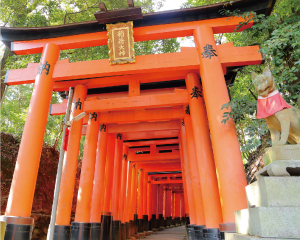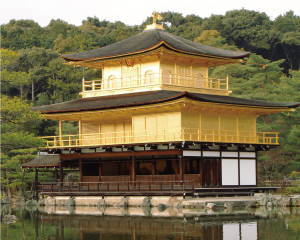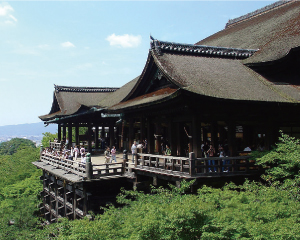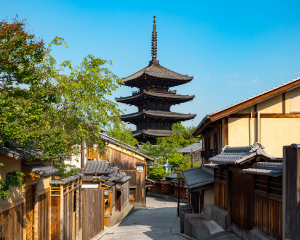


This intriguing shrine was dedicated to the god of rice and sake by the Hata clan in the 8th century. As the role of agriculture diminished, deities were enrolled to ensure prosperity in business enterprises.
The magical, seemingly unending path of over 5000 vibrant orange torii gates that wind through the hills behind Fushimi Inari-taisha Shrine makes it one of the most popular shrines in Japan. The walk around the upper precincts is a pleasant day hike. It also makes for a delightfully eerie stroll in the late afternoon and early evening, when the various graveyards and miniature shrines along the path take on a mysterious air.
This shrine, dedicated to the god of rice and sake in the 8th century, also features dozens of statues of foxes. The fox is seen as the messenger of the god of grain foods, Inari, and the stone foxes are often known by the same name. The keys often depicted in the fox mouths are keys to granaries. This shrine is the central location for some 40,000 Inari shrines throughout the entirety of Japan.

The image of the temple richly adorned in gold leaf reflects beautifully in the water of Kyokochi, the mirror pond.
It is perhaps the most widely-recognized image of Kyoto. Seen reflected in the adjoining "mirror pond" with its small islands of rock and pine, Kinkaku-ji Temple, "The Golden Pavilion," is a breathtaking must-see.
The building's first purpose was to serve the retiring Shogun Ashikaga Yoshimitsu (1358-1409) as a residence. The gold-leaf-adorned building was converted into a Zen temple shortly after his death. In an event that was later fictionalized by the renowned author Yukio Mishima, a 21-year-old monk burned Kinkaku-ji Temple down in 1950. The temple was rebuilt in 1955 and continues to function as a storehouse of sacred relics.
The temple's garden is also a scenic delight and contains in its grounds a charming teahouse.

The expression "to jump off the stage at Kiyomizu" is the Japanese equivalent of the English expression "to take the plunge".
Kiyomizu-dera Temple is perhaps the most popular of the temples in Kyoto and is a fixture in the minds of the Japanese people. The temple's veranda juts out of the side of a mountain supported by 13-meter-high wooden columns. The main hall with its distinctive hip-shaped roof of cypress bark rests to the rear of the veranda and houses within it a priceless statue of Kannon Bodhisattva, the goddess of mercy. From the veranda, one can appreciate fine views facing west over the city of Kyoto. This is an auspicious place to watch the sunset, which may also explain the romantic associations accorded to the temple.
Several other buildings designated as "national treasures" dot the grounds, as do waterfalls and landmarks which have entered popular lore. Thus people come to the temple to drink water from the falls by collecting it in tin cups; the water is said to have therapeutic properties, and drinking from the three different streams is said to confer health, longevity, and success in studies.
There is also a shrine Jishu-jinja Shrine on the grounds, and praying there is said to help one succeed in finding an appropriate love match. People desirous of a romantic partner can be seen walking between two prominent stones with their eyes closed. If one can make the journey alone, this is taken as a sign that the pilgrim will find love. Those who need assistance in making the crossing will require an intermediary to help them find their mate.
The temple is very popular with visitors and has something of a festival atmosphere. Vendors abound who sell talismans, incense, and "omikuji" (paper fortunes). Serious pilgrims come to pray, young people come looking for good fortune in love, visitors come to see the sights, and all fall under the spell of Kyoto's timeless temple.

Hokan-ji Temple is known colloquially as Yasaka-no-to (Yasaka Pagoda). It is a 46-meter tall pagoda with graceful, sloping roofs on each tier, which lies in the middle of an old Kyoto neighborhood, between Kiyomizu-dera Temple and Yasaka-jinja Shrine. It is one of the unexpected treasures that reward the person on a casual stroll through the Higashiyama District.
Visitors are allowed inside to marvel at the tower's architecture, statues and fading paintings. Originally built by the Imperial Prince Shotoku in 589, the pagoda is said to have been inspired by a dream.